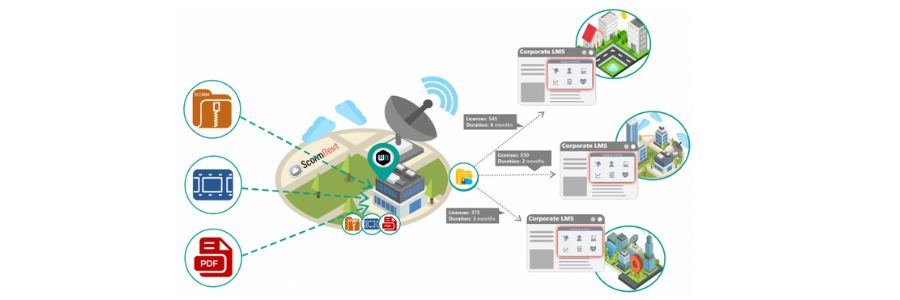In an environment where information advances rapidly, keeping e-learning courses updated for all employees becomes a task that demands both time and financial resources. In this article, we will explore innovative strategies designed to enhance the distribution of your e-learning content and save on resources.
1. Microlearning
Microlearning emerges as a revolutionary strategy that facilitates information assimilation and reduces costs associated with the development and maintenance of extensive courses. This methodology breaks down information into small modules, easing assimilation and retention. The key lies in delivering educational content briefly and tailored to the specific needs of the learner.
2. SCORM content distribution platforms
In the realm of digital education, SCORM platforms stand out as standard tools that significantly simplify the creation, distribution, and tracking of educational materials. SCORM, derived from the Sharable Content Object Reference Model, establishes technical standards enabling interoperability between different Learning Management Systems (LMS) and digital content.
A notable platform in this landscape is scormNEXT, playing a crucial role in securely and efficiently distributing courses to client learning platforms. scormNEXT utilizes formats such as SCORM 1.2, SCORM 2004, or TinCan xAPI, employing a licensing system that allows content creators strict control over access and usage of their educational material. An innovative aspect lies in the secure storage of content on the platform, enabling clients remote access.

Such platforms reduce costs by avoiding duplications and maximizing the utility of existing content. Additionally, they enhance efficient resource distribution, increasing effectiveness without incurring additional expenses.
3. Strategic use of Social Media
Social media enables direct and effective communication with students from diverse locations. Incorporating educational content on channels like Facebook, X (formerly known as Twitter), or LinkedIn becomes an effective means to reach students immediately.
Rather than competing with e-learning platforms, social media can act as complementary allies. Posting updates, summaries, or extra content on these platforms ensures more people see the courses, generating interest and maintaining active participation.
4. Gamification strategies
Gamification is an innovative technique that transforms the learning experience by incorporating playful elements and game mechanics into educational environments. By motivating students through challenges, competitions, and rewards, active participation is encouraged, and material retention is boosted.
This deeper engagement not only reduces the need for repetitions but also decreases course dropout rates, maximizing the reach of online education.
5. Collaboration with educational Influencers
The key is to select influencers whose values and areas of expertise align with the topics covered in the courses. This ensures that the collaboration is consistent and relevant to the audience. The authenticity of the partnership reinforces positive perception and attraction to promoted courses.

In addition to promotion, educational influencers can actively contribute to content. Collaborating in material development or participating in online events adds a valuable element to the learning experience, making courses more appealing.
6. Artificial Intelligence (AI) and Machine Learning
The strategic implementation of Artificial Intelligence (AI) and Machine Learning in e-learning content distribution offers significant opportunities to maximize reach and reduce costs.
AI can personalize learning content based on individual student needs, adapting difficulty and delivery pace. This not only enhances learning effectiveness but also optimizes time usage, reducing the need for unnecessary repetitions.
Moreover, Machine Learning can analyze student interaction patterns and provide personalized recommendations for the next steps in their educational journey. This predictive capability facilitates anticipation of potential difficulty areas, allowing proactive interventions and reducing costs associated with additional support.
7. Interinstitutional collaborations
Interinstitutional collaboration involves not only sharing resources but also expertise. Sharing knowledge and best practices among institutions allows for optimizing the creation and distribution of content, reducing duplications, and leveraging each entity’s specialization.
A key benefit is the diversification of educational offerings. Through collaboration, institutions can expand their course catalog without incurring costs associated with the development and maintenance of new initiatives. Diversification maximizes the efficient use of shared resources.
In conclusion, e-learning content distribution and cost reduction are critical aspects for the continued success of online education. By adopting innovative strategies and exploring new opportunities, educational institutions can not only keep up with changing demands but also lead the educational evolution in the digital era. With a focus on efficiency and quality, online training can become an effective driver for global learning.
